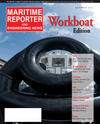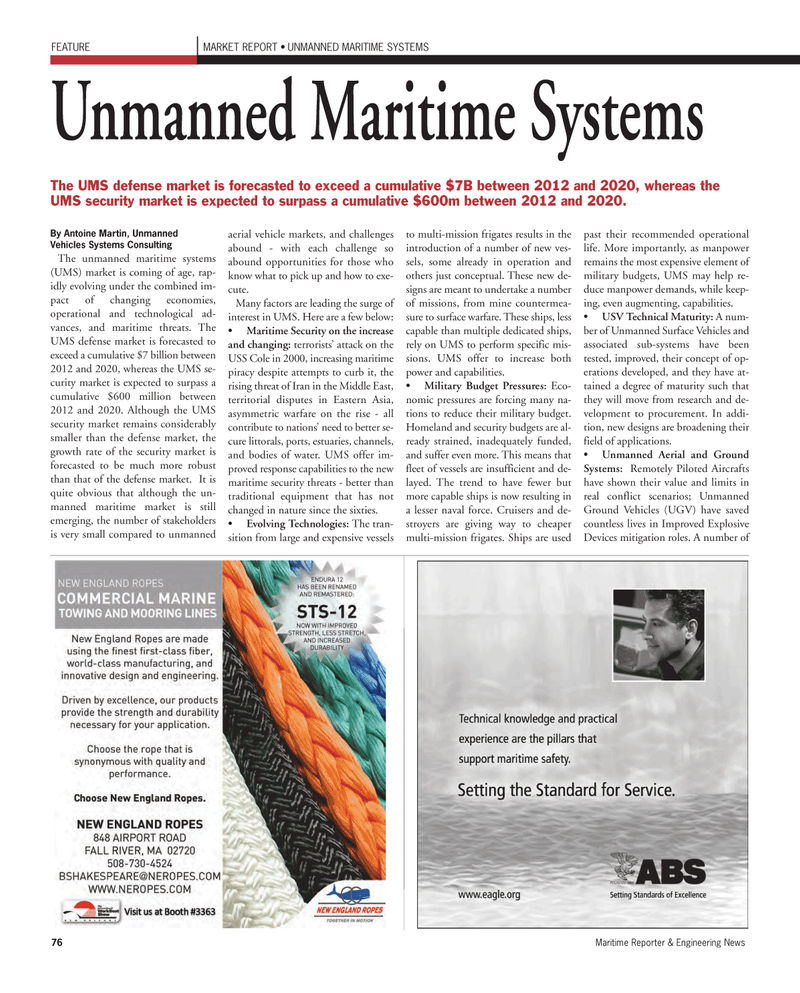
Page 76: of Maritime Reporter Magazine (November 2011)
Feature: Workboat Annual
Read this page in Pdf, Flash or Html5 edition of November 2011 Maritime Reporter Magazine
76Maritime Reporter & Engineering News FEATURE MARKET REPORT UNMANNED MARITIME SYSTEMS Unmanned Maritime Systems The UMS defense market is forecasted to exceed a cumulative $7B between 2012 and 2020, whereas the UMS security market is expected to surpass a cumulative $600m between 2012 and 2020.By Antoine Martin, Unmanned Vehicles Systems Consulting The unmanned maritime systems(UMS) market is coming of age, rap- idly evolving under the combined im- pact of changing economies,operational and technological ad-vances, and maritime threats. The UMS defense market is forecasted to exceed a cumulative $7 billion between 2012 and 2020, whereas the UMS se- curity market is expected to surpass a cumulative $600 million between 2012 and 2020. Although the UMSsecurity market remains considerably smaller than the defense market, the growth rate of the security market is forecasted to be much more robust than that of the defense market. It is quite obvious that although the un- manned maritime market is still emerging, the number of stakeholdersis very small compared to unmanned aerial vehicle markets, and challenges abound - with each challenge soabound opportunities for those who know what to pick up and how to exe- cute. Many factors are leading the surge of interest in UMS. Here are a few below: Maritime Security on the increase and changing: terrorists? attack on the USS Cole in 2000, increasing maritime piracy despite attempts to curb it, therising threat of Iran in the Middle East, territorial disputes in Eastern Asia,asymmetric warfare on the rise - all contribute to nations? need to better se- cure littorals, ports, estuaries, channels, and bodies of water. UMS offer im- proved response capabilities to the new maritime security threats - better than traditional equipment that has notchanged in nature since the sixties. Evolving Technologies: The tran-sition from large and expensive vessels to multi-mission frigates results in the introduction of a number of new ves- sels, some already in operation and others just conceptual. These new de- signs are meant to undertake a number of missions, from mine countermea- sure to surface warfare. These ships, less capable than multiple dedicated ships,rely on UMS to perform specific mis- sions. UMS offer to increase both power and capabilities. Military Budget Pressures: Eco- nomic pressures are forcing many na- tions to reduce their military budget. Homeland and security budgets are al- ready strained, inadequately funded, and suffer even more. This means that fleet of vessels are insufficient and de- layed. The trend to have fewer but more capable ships is now resulting in a lesser naval force. Cruisers and de- stroyers are giving way to cheaper multi-mission frigates. Ships are used past their recommended operational life. More importantly, as manpower remains the most expensive element of military budgets, UMS may help re- duce manpower demands, while keep- ing, even augmenting, capabilities. USV Technical Maturity: A num-ber of Unmanned Surface Vehicles and associated sub-systems have been tested, improved, their concept of op- erations developed, and they have at- tained a degree of maturity such that they will move from research and de- velopment to procurement. In addi- tion, new designs are broadening their field of applications.Unmanned Aerial and Ground Systems: Remotely Piloted Aircrafts have shown their value and limits in real conflict scenarios; Unmanned Ground Vehicles (UGV) have saved countless lives in Improved Explosive Devices mitigation roles. A number of MR Nov.11 # 10 (74-80):MR Template 11/4/2011 10:50 AM Page 76

 75
75

 77
77
